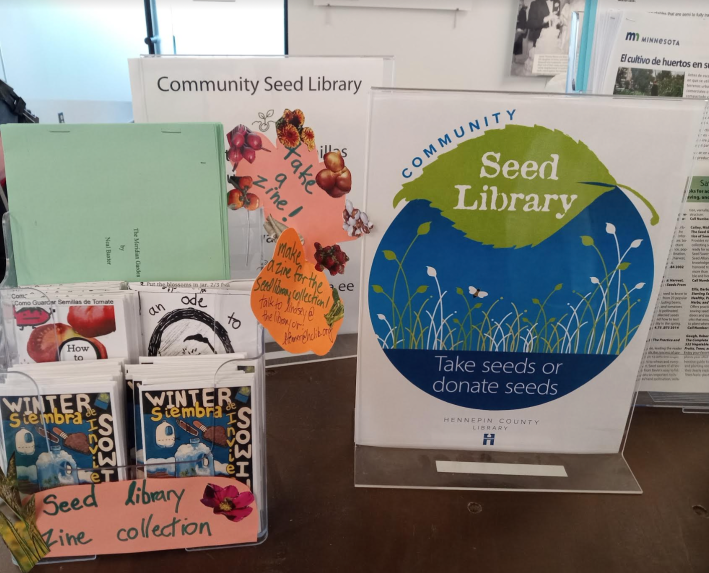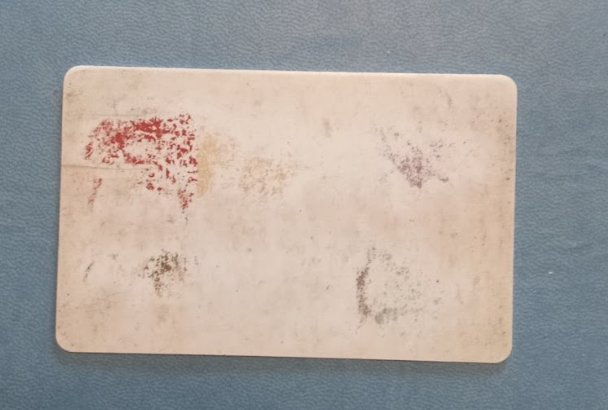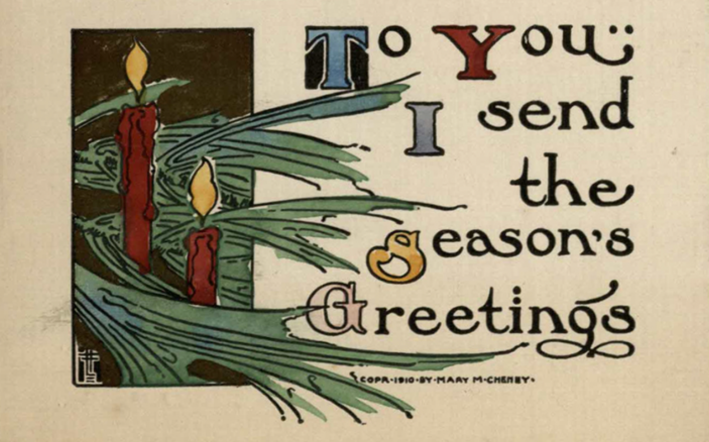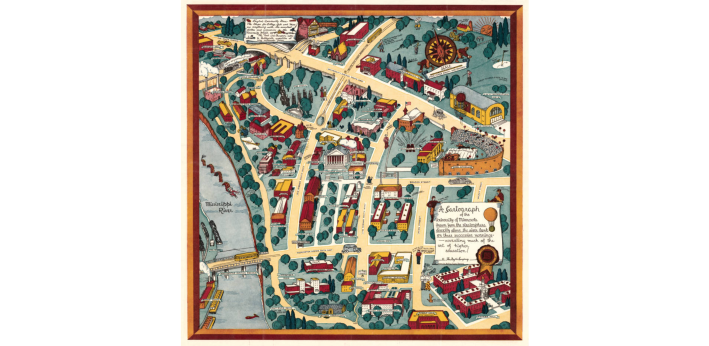“The Nazis themselves couldn’t have asked for a more antisemitic depiction of Jews,” a man is quietly but forcefully contending as he brandishes a DVD.
The librarian on the other side of the desk is a model of noncommittal deference, thanking the patron for bringing this to his attention without either arguing or agreeing. I gotta know what this hate crime of a film is, of course, so I squint across the room and see… the Coen brothers’ A Serious Man.
You never know what’s going to happen at the library.
Don’t worry—this here won’t be another story about banned books, or unruly patrons, or any of the other certainly newsworthy controversies that libraries confront.
Nope, this is just a guide to what our libraries offer today, especially those programs and services that even regular patrons like myself might not know about. And it starts on a sunny Sunday afternoon at my neighborhood library, Hosmer, in south Minneapolis, where a man is not-quite-ranting about the famously Jewish Coens and where I have come with a dumb little task to accomplish.
If you’re like me, you don’t need to print, sign, and scan a document all that often. Not nearly often enough to buy a printer/scanner, anyway. But hey, there’s always the library. The first 50 pages are free to print in Hennepin County; the scanners (free to use) are next to the computer stations.
Beside the computer station is a rack of circulating zines, with a helpful flier explaining the history and purpose of independently crafted magazines. Another flier informs me that there’s a zine club that meets every third Sunday. There are fliers like this everywhere throughout the library, telling you when Fiber Art for Families meets or when the next Community Chess Day is. And Hosmer, like most of our libraries, is full of meeting rooms, where such classes and events are held, and which you can reserve for your own purpose as well.

Visiting a state park? You can check out a seven-day free pass from the library. Planting a garden? There’s a display for a Seed Library by the new books section, and don’t forget to come back for the seed club. And the library meets needs as well as wants. The Sisters Camelot food share will be visiting the Hosmer grounds soon, I learn from another flier. And kids can receive lunch and snacks at the library as well. (Guess how I found that out.)
Speaking of kids, they’re everywhere. The children’s section of the library is essentially a playroom. My good pal Andy, who is the local dad of a local two-year-old, compliments both Hennepin County Library’s Connect & Play and Family Storytime programs and the play areas at every library. “I can't overstate how valuable these spaces are to families in the neighborhood,” he says.
And these are just the offerings I’ve taken in from a casual five-minute scan of one library. There are 40 other branch libraries in the HCL system. And there are 13 branches of the Saint Paul Public Library. Beyond that are eight metro county library systems that make up MELSA, the Metropolitan Library Service Agency, Minnesota’s regional public library system. The Twin Cities Metro is just lousy with libraries.
(Why is there no Minneapolis Public Library? Well, once there was. While the Saint Paul Public Library and the Ramsey County Library have remained distinct, by 2008 the Hennepin County Library system had grown so large that it made good budgetary sense for the two to merge.)
Clearly, there was more to the library than a quick glance around would tell me, and I wanted to learn all their secrets. So I spoke with representatives from both the Hennepin County Library and the Saint Paul Public Library about the offerings that patrons might overlook—or that non-users might not realize they’re missing out on.

“But Keith,” I can hear you librariphobes out there protesting already, “I hate seeds and zines and children. What need have I for some old building full of even older books? The internet is available on my portable telephone!”
Well, my stridently techno-futurist reader, you should know that the library is no longer strictly just a building. Circulating materials such as e-books and e-audio books can be checked out without leaving your home. And maybe more significantly, libraries are putting materials that were once secluded within their in-house archives, and visited primarily by researchers, on the web, where they can be easily explored by all.
The HCL archive digitization program is relatively new. “We started the process about 10 years ago,” says Special Collections Manager Ted Hathaway. “The platform actually launched in November of 2016 with 35,000 objects. We're up to about 260,000 now. We add probably anywhere from 20 to 40 objects every year.”
Newspapers, photographs, maps—all sorts of historical documents, some essential and some ephemeral, are available through the HCL website. (I’ve added a brief guide to some of the more interesting digital collections below.) And, Hathaway tells me, they become useful to people in unexpected ways.
Take the collection related to local artist Mary Moulton Cheney, a name that might not mean much to you or me. “She ran her own business for a time creating things like very high-end book plates and other graphic designs, and a lot of them were associated with Christmas,” Hathaway says, adding that the library highlighted this collection one day and it was soon among the site’s more popular pages. “All the sudden we got hundreds of hits because this collection had lots of great ideas for Christmas designs.”
The HCL website not only connects with the library’s own digital archives and the databases to which it subscribes (and which patrons can often access for free) but with additional resources outside of the library. In fact, as Google has become a more ineffective search engine because of spammy SEO bait, using the library as a digital portal allows you to screen out so much noise. (It’s almost as though publicly funded information systems operate better than those driven by the whims of the market, he mused parenthetically.)
Digitization of the library archives continues—and so does the growth of the special collections. “So right now we have one project worker who is processing the library’s new archival collections and we have another one who is digitizing selected portions from that,” Hathaway says.

As digitization has proceeded, though, library buildings have become more central to people’s lives.
“The physical space for a library has become really important, especially in the last several years with Covid and how much distance we've had to have from each other,” says SPPL Youth and Family Services Manager Kelsey Johnson-Kaiser. “We see so many people really focusing on the importance of connection and belonging and being in social spaces with one another and so we are really striving to be this place that connects people to resources and services.”
The challenge is that the people who are seeking to connect and the resources and services they need are always changing.
“We have new communities coming to St. Paul all the time,” says SPPL Public Service Manager Xenia Hernández. “What we need to offer them is changing month to month. And so we adapt the same strategies—we've got lots of tools to get through that. We've got a language line that we use, we use Google Translate quite a bit, and we’re trying out this little device that helps translate between two people speaking completely different languages and it's like a live translation.”
Changes in technology have also created new needs. “We've gotten a huge increase in people really needing access to the computers and cameras just to do basic video calls, maybe for job interviews or for a therapy appointment,” Hernández tells me.
Interestingly enough, libraries’ experiences during the pandemic, when new programs and services had to be thought up on the fly, have made the institutions more nimble in our era of relative normalcy. “I think we’re more comfortable being in that space where we say we're not quite sure but let's talk about it. Let's try something. Let's adapt and let's keep moving forward,” Johnson-Kaiser says.

Having talked to the library pros about what their systems had to offer, I decided I needed to consult one more expert before wrapping this story up. Between 2019 and 2023, Linda Goecke and her husband Glenn visited all 41 Hennepin County public libraries. (Their project was recapped in this wonderful Chris Hewitt feature in the Star Tribune.) If there was anything I’d missed, surely she’d fill in the gaps.
And sure enough, Goecke reminded me about the grand piano you can reserve in a soundproof room in the Central Library in downtown Minneapolis. And she was also intrigued by that branch’s Vinyl Revival Listening Room, which allows you to listen to old LPs, and hadn’t been up and running yet when she and Glen visited.
And what about the Eden Prairie Library’s unique seed library display?
“Remember the old card catalog?” she asked. “They have a creative use for it in the lobby area. They had seeds in these different drawers that you could take for free.”
But Goecke also pointed out what hadn’t changed at the libraries.
“They have this program where you can bring your child and they can read with a dog,” she said. “I had done that with our grandsons years ago—and they’re in their 20s now.”

A Pathetically Incomplete Guide to Your Local Library
OK, now comes the fun part. Here are some of the programs and services that HCL and SPPL offer, some of which I used regularly (Kanopy!), some I never knew about, others of which I’d forgotten about and meant to get around to using. But really, this is just a starting point. Hop online to find out more—or just go to the library.
Digital Collections
The HCL’s Digital Collections draw about 500,000 users per year. “So if you wanted to compare that with a branch library, that would make us a pretty big one,” Hathaway says. This is just a taste of what’s available online in both HCL and SPPL.
- Hennepin County Yearbook Collection (HCL)—“The most popular collection we have,” Hathaway says. “They say If anybody from any walk of life ends up in a book, it's probably going to be a yearbook.” The collection ranges from 1890-1988, and many are also available in print editions in the library. (St. Paul’s yearbooks are available only in the library.)
- Menus (HCL)—Menus from Hennepin County restaurants stretching from the late 19th century to the 1970s. Perhaps you remember this short-lived Racket feature? “I'm old enough to remember when restaurants in Minneapolis basically sucked and it really comes home when you look at the old menus,” Hathaway says. “It was just meat and potatoes from beginning to end. The English country Roadhouse seems to have been a big theme, and they also tried Asian themes. They wanted to make the experience of eating steak and a baked potato kind of exotic and exciting.” This video takes you on an introductory tour of the menus that await you.
- City Directories (Both)—The directories of Hennepin County residents go through 1950. You can look people up by name, or by street address, and the listings include spouses, children, and jobs. Those from St. Paul go from 1856 to 1922, though print editions through the present are available in the library.
- Humans of Minneapolis (HCL)—A more recent addition to the HCL digital collection is Stephanie Glaros’s 2010-2021 “Humans of Minneapolis” project, which includes more than 700 photographs and 500 interviews with everyday residents of Minneapolis. (Some of the audio is only available at the library.)
- Maps (Both)—Old maps, quite simply, rule. HCL has digitized an incredible selection of historical maps. SPPL has digitized part of the Saint Paul Collection, including an 1891 plat book and a 1925-1927 photographic atlas. It has oodles of other maps in the library itself.

Special Collections
Both libraries have plenty of Special Collections material that hasn’t been digitized, which you can find in the libraries themselves. Here are just a few of the more interesting items.
- Auto Repair Collection (SPPL)—The Hayden Heights Library has an extensive collection of auto repair books, a set of Chilton manuals (the gold standard of such guides, I’m told) dating from 1940 to the present.
- First Avenue posters (HCL)—Just what it says: A selection of old show posters to make you remember when or wish you were there.
- Lil Punks Club Records (HCL)—My first response: I’ve never heard of this record label! Turns out Lil Punks was a group of girls, West High Class of ’41, who made doll clothes, stuffed animals, and scrapbooks for children and sang at nursing homes and hospitals. History!
- Bungalow Collection (SPPL)—The Merriam Park Library is home to a collection of materials on bungalow homes and the Arts & Crafts movement.
Audio/Visual Collections
- Vinyl Revival Listening Room (HCL)—You probably know that you can check out CDs from the library. But did you know you can also enjoy a selection of vinyl LPs at the Central Library?
- Kanopy (HCL)—Library card holders can use the movie streaming service for free. It not only has a great selection of current and classic films, but it’s the only place you can stream the work of the great documentary filmmaker Frederick Wiseman.
- MNspin (HCL)—A broad, deep collection of recordings from Minnesota musicians that are available to stream or download. And the artists even get paid—$200, and they retain all their rights.
Hennepin County Law Library
Not all lawyers are rich, and not all people who need to understand the law are lawyers. The Law Library, located in the Government Center in downtown Minneapolis offers an exceptionally great deal for lawyers—for $85 a year, you have unlimited use of the otherwise pricey Westlaw and Lexis databases, access to other legal databases, and access to document services.
Other online services
- Interlibrary Loan (Both)—Though this is a pretty basic service it’s easy to overlook. MNLINK allows you to check out materials from public and university libraries statewide. I’ve personally tracked down some hard-to-find DVDs and scholarly books too specialized for public libraries this way.
- smARTpass (Both)—This service, available through the library, allows you to reserve free tickets to events at First Avenue, Mia, the Northrop, and plenty of other theaters and institutions.

Other In-Library Services
- Innovation Lab (SPPL)—This incredible resource center allows you to use Singer sewing machines, an American Button Machine, 3D Printers, digitization materials, a recording studio (with a Moog!), a media lab, and plenty more. “A lot of entrepreneurs that come in and create things for their business.” Hernández says. “We have artists use the recording studio, adults that come in with materials that they want digitized things like photographs or film. There's a regular event called Lab After Dark where everyone gets to do an activity and gets to take something home. It's an easy way to get to know the lab and sort of test the waters.”
- Createch (SPPL)—This offers much of the same equipment as the Innovation Lab, but strictly for teens. “We try to have a lot of resources and technology available so that teens get to explore their interests or their passions or try something or learn something in a way that is self-guided and self-directed and allows them to be the one that sort of owns that work,” Johnson-Kaiser says. “The goal is really a space where teens get to be teens and they get to engage with the space and with each other in the ways that feel comfortable for them in a society where we don't have a whole lot of spaces like that for teenagers.” In 2023, 735 teens visited Createch a total of 2,999 times.
- Seed Libraries (HCL)—Patrons can take seeds and donate them as well. Eden Prairie, Hosmer, Nokomis, and St. Louis Park libraries partner organizations as well as harvested seeds in the fall from local growers to keep the seed library plentiful.
- Park Passes (Both)—Free seven-day passes to Minnesota state parks are available at seven Hennepin County libraries and six St. Paul libraries, as well as at libraries across the state.







